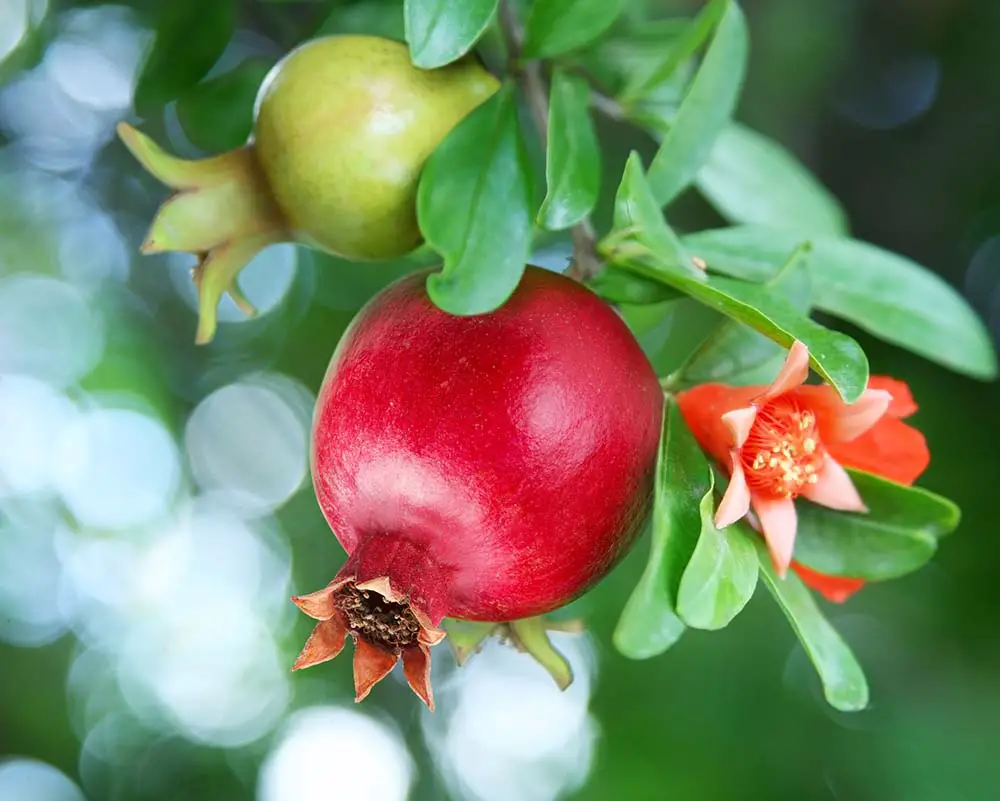
We may receive commissions from purchases made through links in this post, at no additional cost to you.
When I first planted a pomegranate tree I was thrilled at how vigorously it grew. But as the first season passed without the tree showing a hint of blossoms – let alone actual pomegranates – I started to wonder. When will my tree begin to bear fruit?
The first step to successfully growing any fruit tree is understanding the timing of its growing season – only then can you determine how best to care for the tree. In the case of pomegranate trees, when do they begin blooming? How old are they when they bear their first significant crop? How long do pomegranates take to grow, and when are they ready to harvest?
Pomegranate trees begin blooming in mid-spring. The fruits develop over several months and are typically harvested between August and November (February to May in the southern hemisphere), depending on the cultivar. A newly planted tree will bear its first significant crop after 2-3 years.
Homegrown pomegranates are definitely worth waiting for, especially since it’s such a joy to experience the beautiful blossoms and slowly developing fruit. In this article, we’ll look at the whole growing season of pomegranates, from when blooming starts to when the fruits are ready to pick.
What time of year does a pomegranate tree bloom?
Pomegranate trees are not the first to blossom in the spring (I think apricots get that honor), so don’t be concerned if you notice other trees waking up first. They typically begin blooming in mid- to late-spring and continue flowering for a long time.
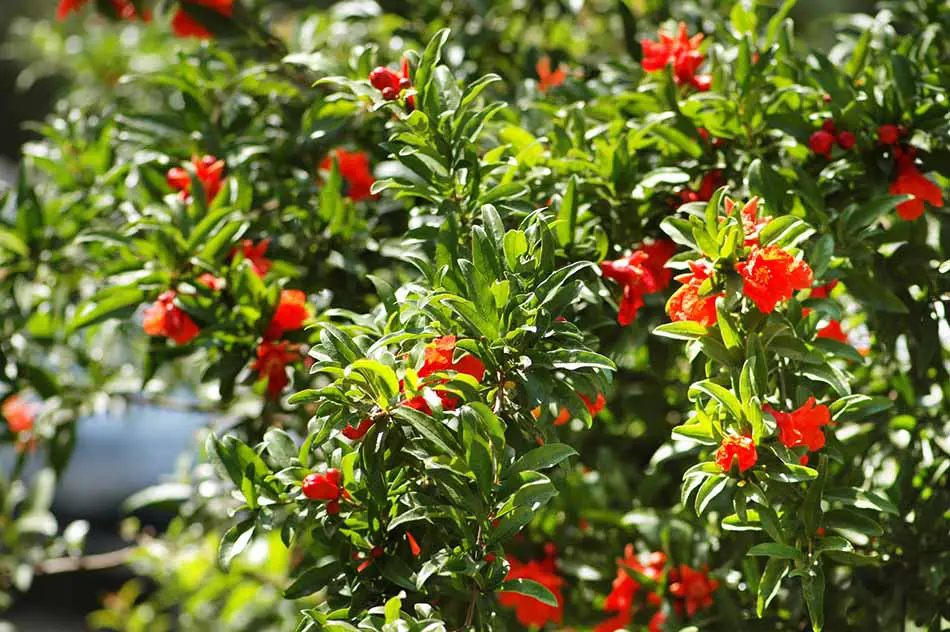
In cooler climates, the flowers typically appear in May to early June (November-December in the southern hemisphere), but in warmer areas, blooming could begin as early as March or April (September-October).
I find that my pomegranate trees have fewer issues with blossom damage from late frosts since the flowers appear a bit later in the spring. Frost damage is certainly still possible with pomegranates, but perhaps less so than many other fruit trees.
Bloom Duration
The blossoms first begin to show up in spring, but pomegranate trees continue blooming off and on throughout the summer and into fall. They will blossom primarily in a few spring flushes, but you may notice flowers all throughout the growing season.
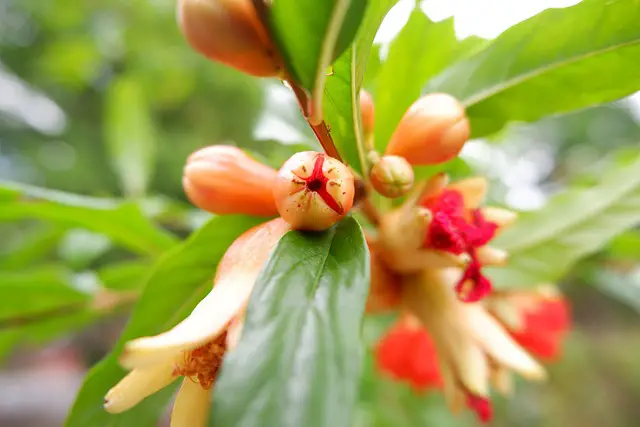
The flowers last for 2-3 weeks before either falling or developing into baby fruit. The earliest blossoms will result in the largest pomegranates since they will have longer to mature on the tree. Later blossoms may not have time to develop fully before winter.
Does a pomegranate tree flower on new or old growth?
Pomegranate blossoms form at the end of the current year’s new growth. Because of this, it’s important to do most pomegranate pruning during the dormant season before new shoots appear in spring. If you prune in the spring or summer, chances are you’ll be cutting off the young fruiting and flowering wood.
However, most of the new fruiting growth appears each spring on 1- to 2-year-old branches. This is why it’s important not to over-prune in the winter. If you cut away too much older wood, the following year’s crop size will suffer.
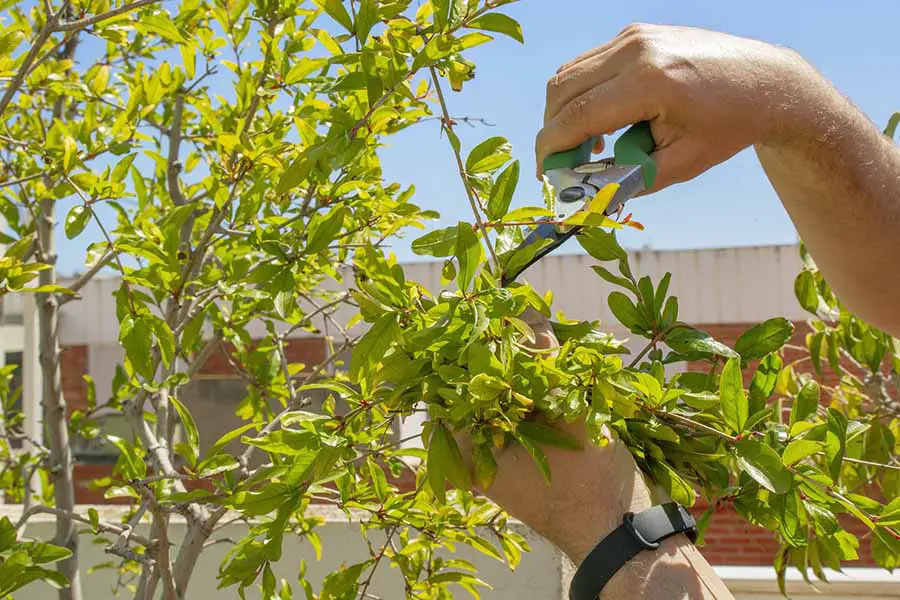
Pomegranate fruiting spurs stick around and produce fruit for several years, so if you cut off too much older growth you will be removing active fruiting wood. One caveat, though – pomegranate bushes frequently send out vigorous shoots from the base of the plant. Whenever these root suckers appear, go ahead and trim them so the plant isn’t wasting energy on unnecessary growth.
All About Pomegranate Blossoms
The blossoms on pomegranate trees are stunning. Hummingbirds love the 1- to 2-inch-long tubular bright flowers that grow in clusters all over the branch tips. Most pomegranate blossoms are bright red, but some cultivars can have orange, yellow, white, or variegated blooms.
Pomegranate trees continue sending out flowers throughout the growing season. Some pomegranate trees do not bear fruit and are only grown for their ornamental properties. Many of these ornamental pomegranates have double flowers with two layers of petals (like a chrysanthemum).
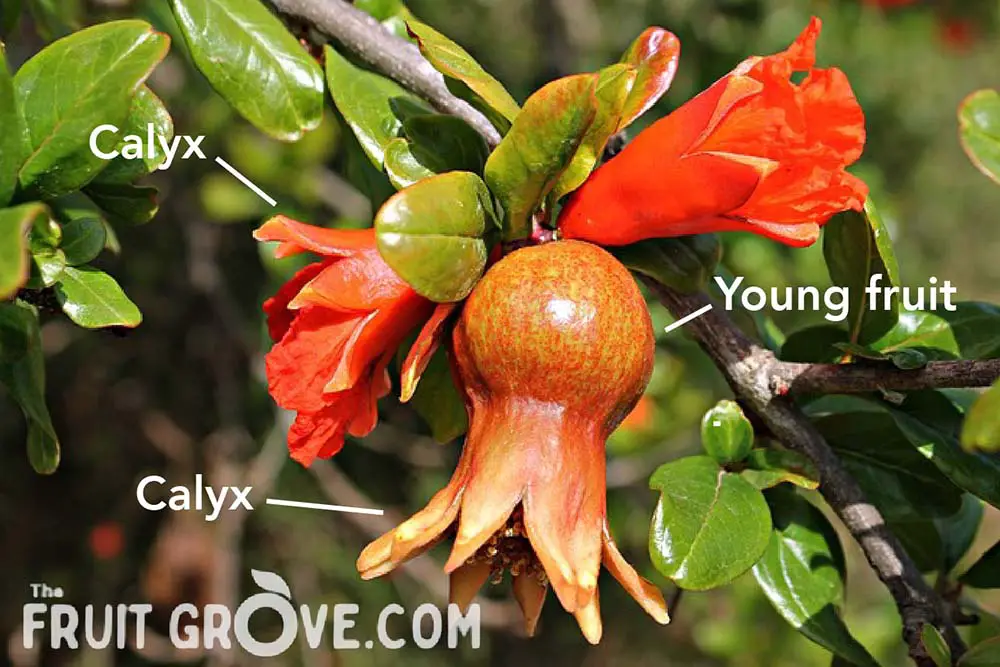
At the base of each flower is a calyx, a protective leaflike structure made up of sepals. The calyx first protects the unopened bud, then supports the flower as it opens. As a pomegranate develops, the calyx remains and becomes the characteristic flared, spiky tips at the top of the fruit.
A Note About Pomegranate Pollination
Pomegranates produce “perfect” flowers, meaning the blossoms both male and female reproductive characteristics. However, each flower can be either productive (with dominant, fully developed female organs), or nonproductive (underdeveloped female parts).
This means that pomegranate trees are self-pollinating, but not every flower will turn into a pomegranate. Only the productive flowers have the necessary anatomy to become fertilized and develop into fruit.
Pomegranates are pollinated by bees, other insects, and hummingbirds. The pollinators fly from bloom to bloom, distributing the pollen that will fertilize the female-dominant flowers. As I mentioned, pomegranate trees are self-fertile, but having a second tree for cross-pollination will result in improved fruit set.
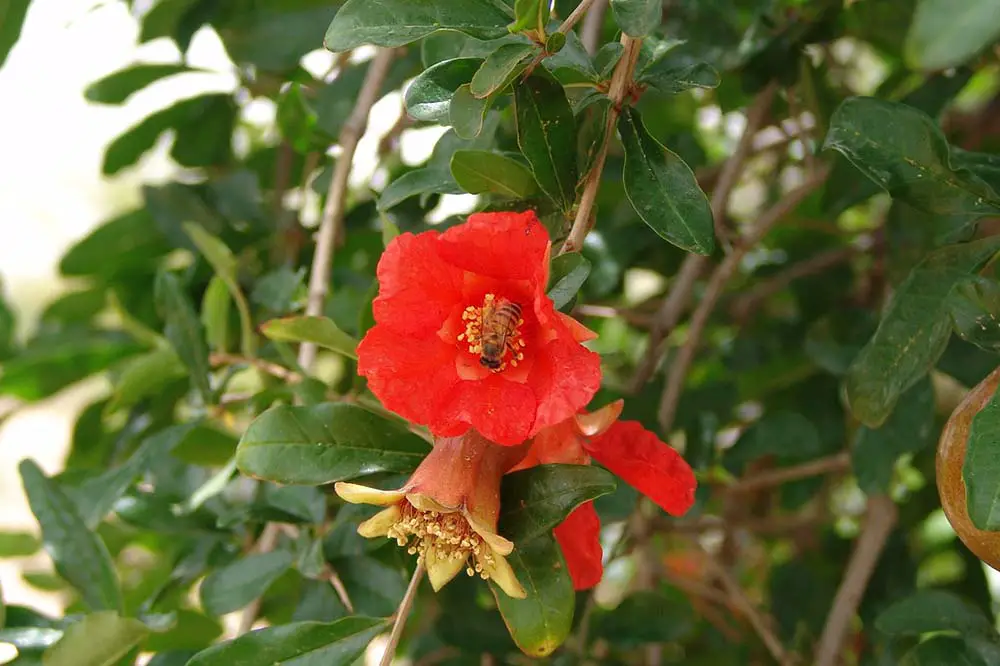
When does a pomegranate tree produce fruit?
It typically takes 2 to 3 years for a young pomegranate tree to produce its first significant harvest. The tree may grow pomegranates as early as the first or second season, but the fruit will likely be underdeveloped or of lesser quality.
As the tree matures, it is able to devote more energy to developing fruit rather than establishing a root system and canopy. Each season that a pomegranate tree grows, the quality and quantity of fruit will increase.
In the first 3 to 5 years of its life, a pomegranate tree may drop a significant number of small fruits in order to keep only what it can support. To prevent excessive fruit drop, avoid over-fertilizing the tree, and be careful to water it consistently.
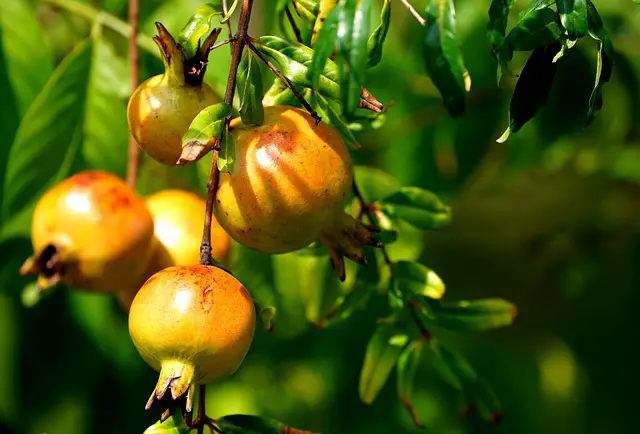
Pomegranates range in color from dark reddish purple, to bright red, to pinkish gold, to peachy white. Depending on the cultivar the fruits could be 2 to 6 inches in diameter, and flavors range from very tart to sugary sweet, and everything in between.
Harvest Time
The range of bright colors could explain why one of the common names for pomegranates is “winter jewels”…although perhaps a more accurate nickname would be “autumn jewels.”
It takes 6-7 months for the fruits to develop from fertilization to harvest time. To estimate when your pomegranates will be ready, take note of when the blossoms begin to open. Add six months to that date, to know when to start checking for signs of ripeness.
Pomegranates are typically ready for harvest in the fall, between September and November, although some cultivars may mature by late July or August in warmer climates. In hot, tropical areas, pomegranate trees continue to flower and fruit year-round.
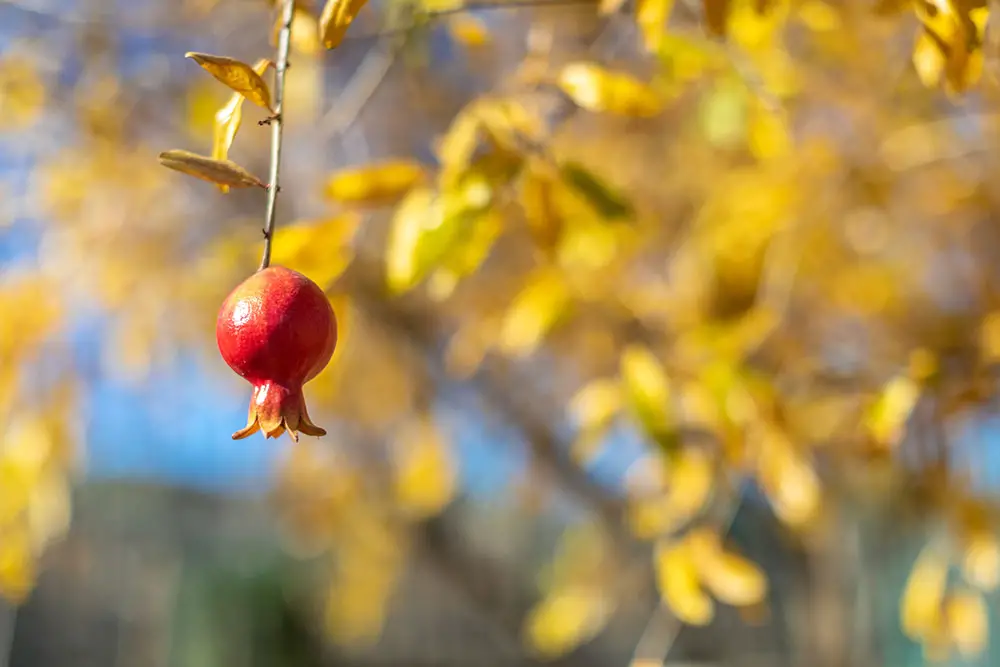
Since spring blossoming happens over many weeks, the fruits will also ripen over a long stretch of time. Each fruit should be individually checked for ripeness. Pomegranates must be left to ripen on the tree so that the flavor and juiciness have time to develop. A pomegranate does not continue to ripen once picked.
Things That Affect Ripening Time and Fruit Quality
Pomegranate trees are heat-loving, and most cultivars need plenty of heat for optimum fruit development. As a result, pomegranates may take longer to ripen in areas with milder summer weather. Conversely, pomegranates grown in a hot climate with warm spring weather (I speak from experience) will be ready sooner.
Excessively rainy, hot weather may result in young pomegranates cracking or splitting. Similarly, a sudden heavy rain in the middle of drought conditions will cause the fruit to split before it ripens.
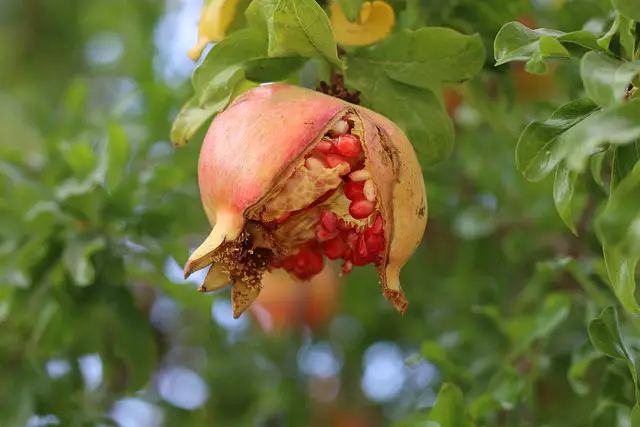
Certain diseases such as anthracnose or heart rot could stunt the growth of pomegranates and prevent them from maturing. Watch for signs of disease stress, such as spots or discoloration on leaves and fruit.
Different pomegranate varieties will be ready for harvest at different times. For example, the popular ‘Wonderful’ pomegranate is ready to pick in early- to mid-fall (typically September/October). ‘Sirenevyi’ is a late-season pomegranate, and will be fully mature as late as November.
How much fruit does a pomegranate tree produce?
Pomegranate trees are very prolific producers. A tree that’s been planted for four years can produce about 10 pounds of fruit (20-25 pomegranates). The harvest will increase every year – after about 10 years you may get over 100 fruits per pomegranate bush. A full-grown pomegranate bush may result in up to 75 pounds of fruit per year – that’s over 200 pomegranates!

